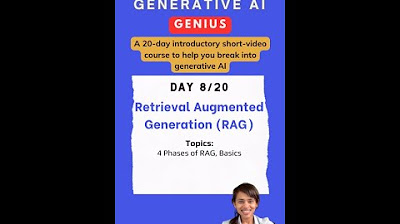What is Retrieval-Augmented Generation (RAG)?
Summary
TLDRMarina Danilevsky, a Senior Research Scientist at IBM, explains Retrieval-Augmented Generation (RAG) for improving large language models (LLMs). She highlights the issues of outdated information and lack of sources in LLM responses. RAG addresses these by combining LLMs with a content store, ensuring answers are both current and sourced. This method retrieves relevant information before generating a response, reducing hallucinations and improving accuracy. Danilevsky emphasizes the importance of enhancing both the retriever and generative aspects of RAG for optimal performance.
Takeaways
- 🧠 Large language models (LLMs) generate text in response to prompts but can sometimes provide outdated or incorrect information.
- 🔍 The speaker, Marina Danilevsky, introduces Retrieval-Augmented Generation (RAG) as a framework to improve the accuracy and currency of LLMs.
- 🌌 An anecdote about the number of moons around planets illustrates the common issues of LLMs: lack of sourcing and outdated information.
- 📚 RAG incorporates a content store, which can be the internet or a closed collection of documents, to provide up-to-date and sourced information.
- 🔄 The RAG framework instructs the LLM to first retrieve relevant content from the content store before generating a response to a user's query.
- 📈 By using RAG, LLMs can provide evidence for their responses, addressing the challenge of outdated information without needing to retrain the model.
- 🔗 The framework helps LLMs to pay attention to primary source data, reducing the likelihood of hallucinating or leaking data.
- 🤔 RAG encourages the model to acknowledge when it does not know the answer, promoting honesty and avoiding misleading information.
- 🛠️ Continuous improvement of both the retriever and the generative model is necessary to ensure the LLM provides the best possible responses.
- 📈 The effectiveness of RAG depends on the quality of the retriever, which must provide high-quality grounding information for the LLM.
- 👍 The script concludes with an encouragement to like and subscribe to the channel for more insights on RAG and related topics.
Q & A
What is the main topic discussed in the video script?
-The main topic discussed in the video script is Retrieval-Augmented Generation (RAG), a framework designed to improve the accuracy and currency of large language models (LLMs).
Who is Marina Danilevsky?
-Marina Danilevsky is a Senior Research Scientist at IBM Research, and she introduces the concept of RAG in the script.
What is the 'Generation' part in the context of large language models?
-The 'Generation' part refers to the ability of large language models (LLMs) to generate text in response to a user query, also known as a prompt.
What are the two main challenges with large language models as illustrated in the anecdote?
-The two main challenges are the lack of a source to support the information provided and the outdatedness of the information, which can lead to incorrect responses.
What is the current number of moons orbiting Saturn according to the script?
-According to the script, Saturn currently has 146 moons.
How does RAG address the issue of outdated information in LLMs?
-RAG addresses the issue by incorporating a content store that can be updated with new information, ensuring that the LLM can access and generate responses based on the most current data.
What is the role of the content store in the RAG framework?
-The content store in the RAG framework serves as a source of up-to-date and relevant information that the LLM can retrieve and use to inform its responses to user queries.
How does RAG help to reduce the likelihood of an LLM hallucinating or leaking data?
-RAG reduces the likelihood by instructing the LLM to pay attention to primary source data before generating a response, which provides a more reliable grounding for the information provided.
What is the importance of the retriever in the RAG framework?
-The retriever is crucial in the RAG framework as it provides the LLM with high-quality, relevant data that forms the basis for the model's responses, improving the accuracy and reliability of the information generated.
What is the potential downside if the retriever does not provide the LLM with high-quality information?
-If the retriever does not provide high-quality information, the LLM may not be able to generate accurate responses, even to answerable user queries, which could lead to a lack of response or misinformation.
What does the script suggest about the future work on improving LLMs?
-The script suggests that future work will focus on improving both the retriever to provide better quality data and the generative part of the LLM to ensure richer and more accurate responses to user queries.
Outlines

This section is available to paid users only. Please upgrade to access this part.
Upgrade NowMindmap

This section is available to paid users only. Please upgrade to access this part.
Upgrade NowKeywords

This section is available to paid users only. Please upgrade to access this part.
Upgrade NowHighlights

This section is available to paid users only. Please upgrade to access this part.
Upgrade NowTranscripts

This section is available to paid users only. Please upgrade to access this part.
Upgrade NowBrowse More Related Video

Introduction to Generative AI (Day 7/20) #largelanguagemodels #genai

Turn ANY Website into LLM Knowledge in SECONDS

Beyond the Hype: A Realistic Look at Large Language Models • Jodie Burchell • GOTO 2024

RAG vs. CAG: Solving Knowledge Gaps in AI Models

RAG From Scratch: Part 1 (Overview)

Fine Tuning, RAG e Prompt Engineering: Qual é melhor? e Quando Usar?
5.0 / 5 (0 votes)